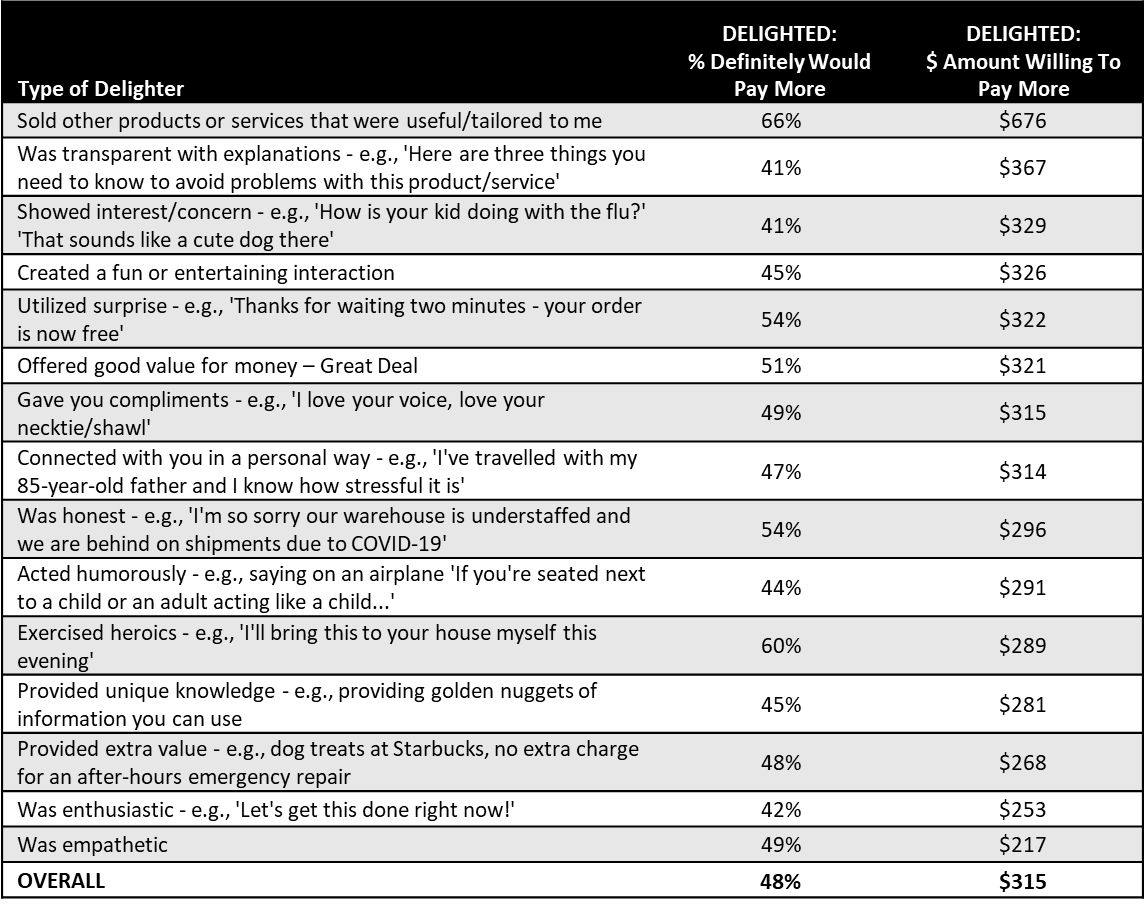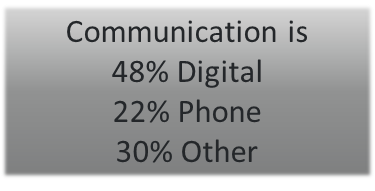Five Reasons to Invest in Customer Delight
Contact centers have traditionally focused on solving problems and handling questions. Efficiency has been the watchword. New research suggests that spending a little more time on the phone or chat may provide big payoffs in terms of revenue, word of mouth and margins. CCMC, sponsored by VIPDesk, surveyed 2519 affluent consumers on their delight experiences over the last six months.
Surprising findings include:
-
Honesty and transparency are powerful delighters
Customers want to know the limitations of products and services they buy. Therefore, honesty and transparency, highlighted in yellow in Figure 1, are two of the top delighters. This is especially important in industries with complex or confusing products and contracts. For instance, in the auto industry, honesty and transparency are as important in producing delight as getting a great price. The right column in Figure 1 shows the rank ordering of the most important type of delight experienced by consumers.
Figure 1: Prevalence of Delight Experiences and Rank Ordering of Most Important Delight Experience
|
Type of Delighter
|
% Mentioned As Delighter
|
% Top Delighter
|
|
Offered good value for money
|
34%
|
12%
|
|
Was honest - e.g., 'I'm so sorry our warehouse is understaffed and we are behind on shipments due to COVID-19'
|
35%
|
10%
|
|
Was enthusiastic - e.g., 'Let's get this done right now!'
|
33%
|
10%
|
|
Was transparent with explanations - e.g., 'Here are three things you need to know to avoid problems with this product/service'
|
29%
|
8%
|
|
Showed interest/concern - e.g., 'How is your kid doing with the flu?' 'That sounds like a cute dog there'
|
27%
|
6%
|
|
Created a fun or entertaining interaction
|
27%
|
9%
|
|
Was empathetic
|
25%
|
6%
|
|
Provided unique knowledge - e.g., providing golden nuggets of information you can use
|
25%
|
7%
|
|
Connected with you in a personal way - e.g., 'I've travelled with my 85-year-old father and I know how stressful it is'
|
21%
|
6%
|
|
Provided extra value - e.g., dog treats at Starbucks, no extra charge for an after-hours emergency repair
|
20%
|
7%
|
|
Utilized surprise - e.g., 'Thanks for waiting two minutes - your order is now free'
|
19%
|
6%
|
|
Gave you compliments - e.g., 'I love your voice, love your necktie/shawl'
|
17%
|
3%
|
|
Sold other products or services that were useful/tailored to me
|
16%
|
4%
|
|
Acted humorously - e.g., saying on an airplane 'If you're seated next to a child or an adult acting like a child...'
|
15%
|
2%
|
|
Exercised heroics - e.g., 'I'll bring this to your house myself this evening'
|
13%
|
4%
|
-
Cross-selling is a major delighter
As noted by the green highlight in Figure 1, 16 percent of consumers mentioned being delighted by being cross-sold other products. In Figure 2, we show that, of those delighted by a cross-sell, 66 percent indicated they would pay more for the same products from that company. The critical requirement is that the cross-selling is appropriate and tailored to the customer, which means that the CSR must know what the customer already has, and their needs, based on their persona or history.
Figure 2. Willingness to pay more for the same products from company due to delight

While customers do not usually like sales pitches, if they feel you are trying to accessorize or help resolve a current gap in the overall experience, they will welcome the suggestions and walk away feeling delighted. For example, Harley Davidson finds most riders want to personalize their motorcycle and are enthusiastic to spend a great deal, often as much as the basic price of the bike, on chrome and other accessories.
-
Delight can be delivered cheaply via customer service representative actions, behaviors and words
The 15 approaches to delight range from inexpensive transparency, patient/detailed explanations and tailored experiences delivered by empowered employees - to enthusiasm and quirky humor - to more costly actions, such as surprise freebies, discounts and very low prices.
In the 15 approaches listed on the left-hand column of Figure 2, at least eight are produced solely by customer service representative (CSR) communication/interaction with the customer and have no tangible cost beyond the application of creativity by the CSR and their talk or typing time expenditure. This figure also shows the percentage of customers experiencing a particular delighter who indicated they would pay more for the same product from the same company based on being delighted. Surprisingly, the CSR behaviors produced almost exactly as many customers willing to pay more as the more costly “great deal” and “freebies” (42-54 percent vs. 48-51 percent). Finally, the experience that leads to the most consumers willing to pay more (66 percent) is being cross-sold other products that were useful, which produces more revenue.
Delight can be achieved by personal interaction as easily as monetary means. For many delighters, the only expenditure required is the time to listen and then respond with emotion and information. The eight actions highlighted with green arrows are all low effort, but very effective delight actions.
What action creates delight can also vary by customer and can often be literally opposite experiences tailored to the customer. For example, at the Club Floor of a five-star hotel in Tokyo at 7 AM, I looked for the usual coffee urn to grab a quick cup of coffee. There was not one in sight. I was approached by a staff person who said a self-service urn “would not be personal service and we want to serve each cup personally, even if it takes more time.” Personal service could include providing coffee both ways, so that two different segments can be simultaneously delighted.
-
Word of mouth (WOM) and intention to repurchase from delighted customers is more impactful than WOM from satisfied customers
In past studies, we found that satisfied customers will tell several friends and acquaintances about their satisfactory experience. When we take the next step of asking, “to the customer’s knowledge, how many of those told about the satisfactory experience actually act on the recommendation?” we found that about 20 percent of those told are reported to have taken action. In this study of delight experience and resulting market actions, results for the same question show that, across all industries, an average of 50 percent of those told about a delight experience were reported by the respondent to have taken action on the recommendation. The range was 36 percent for auto to 69 percent for beauty and fragrance.
This means that if six people are told (a median across all industries), at least two people take action on the delight recommendation. This is twice the reported impact of WOM from customers reporting good or satisfying service.
Figures 3 shows the possible quantification of the impact of a delight experience for the e-commerce industry based on the subsamples from that industry. Sixty-six percent of customers told a median of 4.7 people about their delight experience and an estimated 60 percent of those told took action, meaning that for each customer delighted, 1.9 new customers may be generated.
We recognize that the self-reported information on how many of those told acted on the referral is a weak metric. Across dozens of studies, the data is consistent, and we agree that better metrics are needed. This is an area for additional experimentation, especially within online social communities where closer measurement and tracking of future purchases is possible.
Figure 3: Calculating the Impact of Word of Mouth from Delight on Winning e-Commerce Customers
Our analysis of the top box (“definitely will repurchase”) intention to repurchase the product again (for ten product/industry categories) was 5-9 percent higher for delighted customers than for customers who were not delighted but still declared their experience the best in the last six months. This finding refutes the contention by the January 2012 Harvard Business Review article, “Stop Trying To Delight Your Customers,” that delighting customers produces no consistent payoff.
Delight can be delivered digitally
One of the greatest surprises came from the question about the primary channel used for communication with the company. Forty eight percent of delighted customers reported that they used digital channels: email, chat or social media. Figure 4 shows the breakdown of channels for the primary delight experience.
Figure 4: Primary channel by which delightful experience was created.


Figure 5, which reports channels used for all delight events (not just the most important) shows that every type of delight could be delivered by any of the channels. We did not expect that emotional messages such as enthusiasm and empathy could be delivered easily via digital channels. In fact, delight is almost as easily created by email and chat as in person or over the phone interactions. In addition, we found that live video chat calls were one of the most-mentioned channels as a source of delight.
Figure 5: Primary channel used to create delight

Implications for Action by Contact Center Management
-
There must be transparency and honesty in all sales and marketing messages. Such transparency not only fosters delight, it prevents many problems by setting proper customer expectations.
-
Service should train that cross-selling, intelligently done, is a delighter which is doing the customer a service, whether it is adding a needed financial product or mascara and face powder to a lipstick purchase.
-
CX and service should focus investing in the needed talk time, training and empowerment of CSRs to deliver the eight humanistic experiences that cause delight - from empathy and enthusiasm to transparency, interest and concern. Further, supervisors must be directed to encourage delight and use monitoring and measurement tools to effectively evaluate its delivery across all channels.
-
CX and marketing must adapt delight techniques to digital channels. The fact that 48 percent of delight is delivered digitally now in an unsystematic manner means that much more can be delivered if a conscious effort is made and A/B experiments run to identify the most successful strategies.
-
Service should work with Insights to more effectively categorize and measure delight and measure the impacts of WOM across all channels. Service must be portrayed to marketing as the Word of Mouth Management Mechanism.
-
While this study focuses on affluent consumers, remember that WOM is more important in B2B markets than B2C. 70-90% of new customers are acquired via referrals. Therefore, everything posited here for consumer contact centers applies in spades for B2B centers.
Summary
Creating delight should not be an afterthought or viewed as an extra contact center expense, it should become a primary focus for every manager.
John Goodman is Vice Chairman of Customer Care Measurement & Consulting, For a more detailed summary of the study, go to customercaremc.com or contact at jgoodman@customercaremc.com